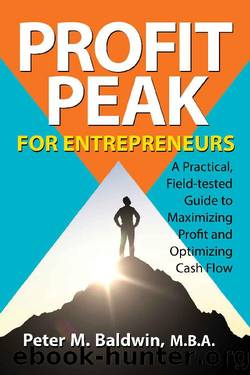Profit Peak for Entrepreneurs by Peter Baldwin

Author:Peter Baldwin [Baldwin, Peter]
Language: eng
Format: epub
Publisher: Your Ten Percent, LLC
Published: 2020-08-16T05:00:00+00:00
Assets are further sub-categorized on the balance sheet as either current, fixed, or other. Current assets are ones that are either already cash or easily converted to cash; accounts receivable and inventory qualify here. Fixed assets consist of properties and equipment that are used to either run the firm or are listed as a non-operational firm investment. Other assets donât easily fit into the first two categories and might include lease deposits and prepaid expenses.
Liabilities are sub-categorized into current, long-term, and other. The difference between current and long-term liabilities is that current liabilities are due and payable within one year while long-term liabilities are any portion that will be paid outside of the next 12 months. Other liabilities include anything not in the first two categories, such as a tenant security deposit.
The equity section of the balance sheet may have different names (depending on the type of legal entity used for the business) but the function is the same. This section includes the initial investment in the firm used to purchase equity shares or partnership interests, retained earnings from prior years, net income or loss from the current year, and any payments to owners that decrease net worth.
Maximizing assets and minimizing liabilities is the first and primary goal of a business. The eventual second goal is to optimize the amount of assets on the balance sheet by paying cash out as dividends or owner distributions as appropriate.
The relationship between current assets and current liabilities is known as liquidity and can be listed as working capital (current assets minus current liabilities) and current ratio (current assets divided by current liabilities). Liquidity measures the ability of the firm to pay its bills in a timely manner. Sometimes the current ratio is further modified into a quick ratio by removing inventory from the numerator. The goal is to have more current assets than current liabilities. A positive value is expected in the case of working capital and a ratio of better than one to one is expected in the case of the current and quick ratios. Of course, the baseline expected values vary by industry and a higher value is always more favorable than a lower one.
Download
This site does not store any files on its server. We only index and link to content provided by other sites. Please contact the content providers to delete copyright contents if any and email us, we'll remove relevant links or contents immediately.
Zero to IPO: Over $1 Trillion of Actionable Advice from the World's Most Successful Entrepreneurs by Frederic Kerrest(4075)
Machine Learning at Scale with H2O by Gregory Keys | David Whiting(3660)
Harry Potter and the Goblet Of Fire by J.K. Rowling(3619)
Never by Ken Follett(3549)
Ogilvy on Advertising by David Ogilvy(3351)
Shadow of Night by Deborah Harkness(3182)
The Man Who Died Twice by Richard Osman(2823)
Book of Life by Deborah Harkness(2726)
My Brilliant Friend by Elena Ferrante(2707)
How Proust Can Change Your Life by Alain De Botton(2620)
0041152001443424520 .pdf by Unknown(2608)
Will by Will Smith(2593)
The Tipping Point by Malcolm Gladwell(2566)
How to Pay Zero Taxes, 2018 by Jeff A. Schnepper(2505)
Purple Hibiscus by Chimamanda Ngozi Adichie(2503)
Hooked: A Dark, Contemporary Romance (Never After Series) by Emily McIntire(2428)
Rationality by Steven Pinker(2159)
Borders by unknow(2121)
Daughter of Smoke and Bone by Laini Taylor(2086)
